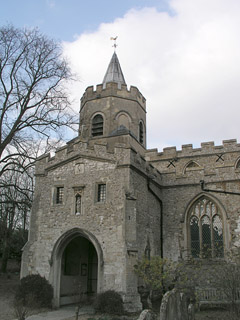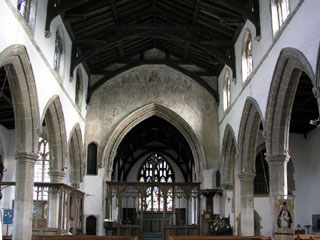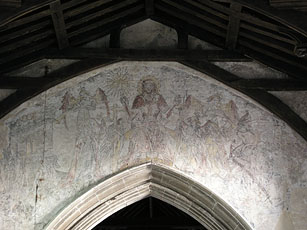On Thursday 6th of November 2003 I had an exhilarating supervision and came out as high as a kite. It was a peculiarly warm day for the time of year, with a bright blue sky and the sun blazing down. With little difficulty I decided to eschew the library and go out for a ride on my bike.
I came to Great Shelford down the road from Trumpington, which meant that I had to drag through dull suburbia to get there. Nevertheless, the core of the village is actually very lovely - lots of beautiful timber framed buildings and winding streets. The church itself is also very nice from the outside. There's an interesting tower with an octagonal top - this is actually 19th century, the original having fallen in 1798, but it looks surprisingly plausible - and a colossal beech glowed red-gold over the chancel and high clerestory.
The porch, which is very big. has a rib vault over the entry, and presumably a parvise up above; the vault itself is rather nice and had some good bosses, including a pelican in her piety. The porch is perpendicular, like most of the church, aside from a few bits and bobs. St Mary was almost entirely rebuilt in the 15th century by Thomas Patesley, Rector here from 1396-1415. His brass lies under a rug next to the high altar, and a big rubbing of it hangs at the west end. They seem quite proud of him - it seems from the guidebook that his patron became Archbishop of York, but Patesley turned down the offer of preferment to stay in Shelford and beautify his church.
He did a very good job. The nave is big, and would have been bigger - when the tower fell, they apparently shortened the nave by three bays. They must have reused the arch, though, for it is classical early Perpendicular. So too are the grand nave arcades. They have little heads above the capitals - all female save for one rather effete looking bearded man in the north-west corner. The guidebook speculates - with no reason, as far as I can see - that it might be a portrait of the master mason. I speculated, given the weak chin and the style, that it might be a portrait of the new King, Henry Bolingbroke. I have no more reason for my guess than the guidebook has, though, and the figure doesn't have a crown. Maybe I saw Richard II too many times at the Globe over the summer.
The nave roof is a fine one, with alternating tie and hammer beams. The latter are carved with angels carrying scrolls, shields and things. You might be forgiven for missing them at first, though, for the first thing that catches your eye when you look up is the amazing doom painting over the chancel arch. It is quite extraordinary, and has, apart from the bottom left hand corner, survived remarkably well - the colours are faded, of course, but it was still easy to make out most of the action.
Christ sits on a rainbow in the middle, with the sun and the moon in attendance on either side of him. Two angels with coronets blow very long trumpets to announce the day of judgment, and another angel grins proudly as he carries instruments of the passion: the spear and sponge on a long pole. Mary intercedes for sinners to one side, while below we can dimly see some unfortunate souls being dragged into Hell by chains. The image of Hell has, sadly, been destroyed - the writer of the guidebook was relieved, since they had apparently worried that it might be rather frightening, but without it the apocalyptic vision is somewhat bowdlerised. Still, it's a marvellous sight.
Below the chancel arch, the original rood screen survives. This is very beautiful indeed, with extremely fine tracery in the arches. All of the paint has gone, alas, but several green men survive in the spandrels on the east side. There's also a little parclose screen enclosing the end of the north aisle - like the main screen it is from the 15th century, but it is much less elaborately decorated and looks almost minimalist by comparison. There is no screen in the other aisle, but the 1636 pulpit is quite good.
The chancel itself was redecorated by the Victorians in high William Morris fashion. They've done it very well. The roof itself is painted in dark reds and greens, and it rests on medieval corbels carved into the shapes of balls of leaves. These have been gilded. It provides a fine setting for Patesley, and don't forget to take a look at him before you go - this is a beautiful church, and he should be as proud of it as his inheritors are of him.
St Mary the Virgin was open both times I visited


